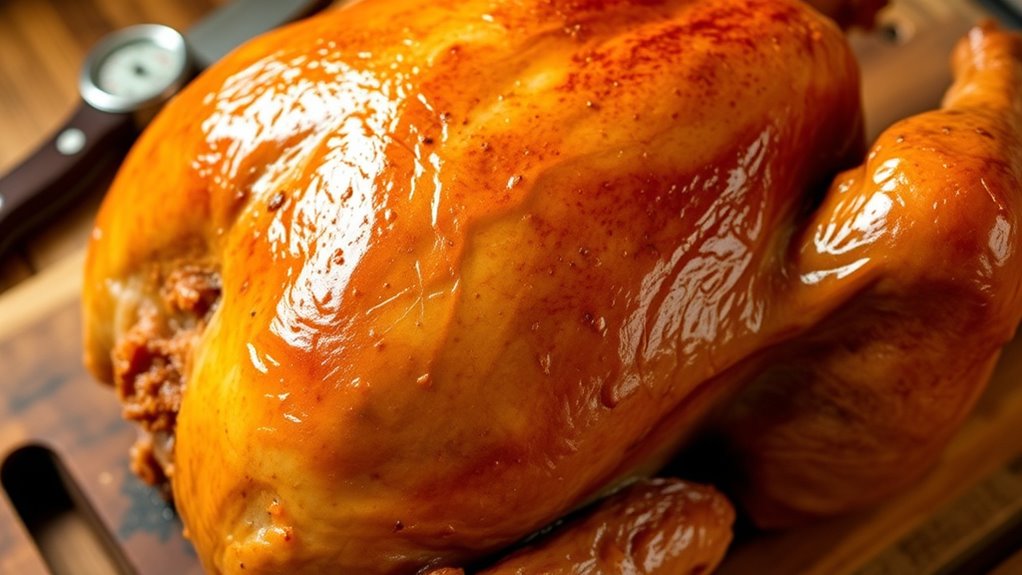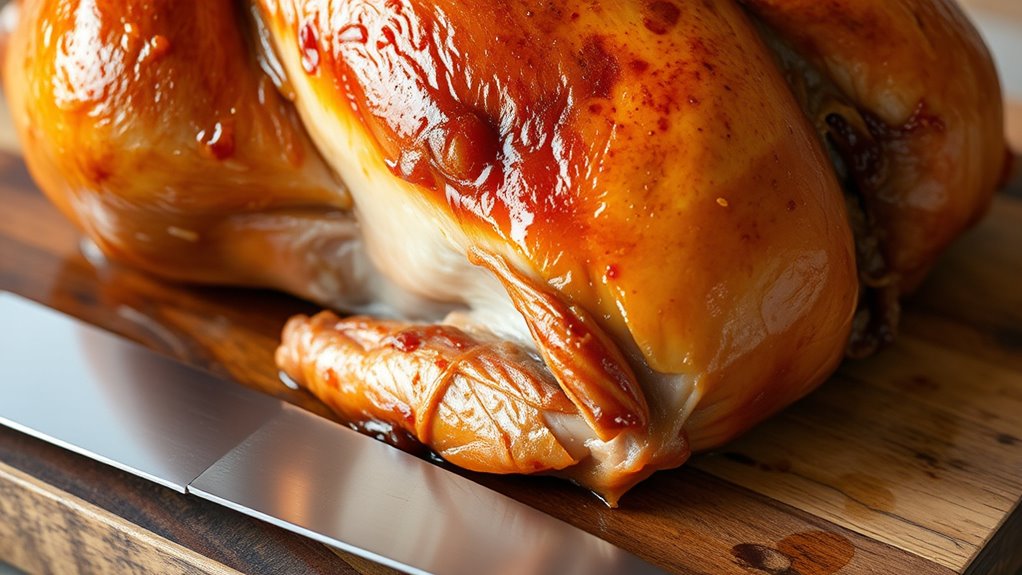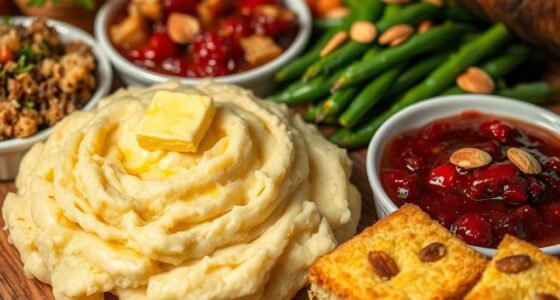To troubleshoot issues like dryness or undercooking, make sure you use a reliable meat thermometer to verify the thickest part of the turkey reaches 165°F. Rest the turkey for at least 20 minutes before carving to keep juices in. Cover it with foil if it browns too quickly, and baste regularly to add moisture. Serving with gravy or sauces can help, too. Keep these tips in mind to perfect your turkey—more details can guide you further.
Key Takeaways
- Use a food-safe thermometer to verify turkey and stuffing reach at least 165°F for safety and proper doneness.
- Rest the turkey for 20 minutes before carving to retain juices and prevent dryness.
- Cover the turkey with foil during roasting to prevent over-browning and moisture loss.
- Prepare stuffing separately or loosely stuff the bird to ensure even cooking and safety.
- Baste periodically or serve with gravy to improve moisture and flavor if the turkey is dry.

Are you struggling to get your turkey just right? It’s a common challenge, but with a few tips, you can troubleshoot those issues and serve a perfect bird. One area where many people get stuck is deciding on stuffing options. If you choose to stuff your turkey, make sure to do it safely. Stuffing adds flavor, but it can also increase cooking time and risk uneven heat distribution. To avoid undercooked stuffing, prepare it separately or stuff the bird loosely, ensuring enough space for heat to circulate. Always check the internal temperature of both the stuffing and the turkey itself—both should reach 165°F. If your stuffing isn’t cooking thoroughly, consider baking it separately in a casserole dish, which is a reliable way to guarantee it’s cooked through without jeopardizing the safety of your turkey.
When it comes to carving techniques, proper execution can make all the difference in presentation and juiciness. After resting your turkey for at least 20 minutes, transfer it to a carving board. Use a sharp carving knife and a sturdy fork to stabilize the bird. Start by removing the legs and thighs, then slice the breast meat against the grain for tender slices. If you notice your turkey is dry, it’s likely overcooked or not rested enough. To prevent dryness, baste the bird periodically during roasting, or cover it with foil if it’s browning too quickly. Resting is vital—don’t skip it. It allows juices to redistribute, resulting in more flavorful, moist slices. When carving, aim for clean, even slices rather than tearing the meat apart; this preserves the bird’s moisture and makes for an elegant presentation.
Another common issue is undercooked turkey. To avoid this, use a reliable meat thermometer and check the thickest part of the breast and the innermost part of the thigh. If either registers below 165°F, pop the turkey back in the oven. If your turkey is overcooked and dry, brining beforehand can help retain moisture and enhance flavor. Also, consider covering it with foil during the last part of roasting to prevent excessive browning. If you find yourself with a dry bird, serving it with gravy or a flavorful sauce can salvage the dish. Remember, the key to troubleshooting turkey problems is preparation, monitoring, and patience. With the right stuffing options and carving techniques, combined with attention to internal temperature, you can turn a potential disaster into a delicious success.
Frequently Asked Questions
How Can I Prevent My Turkey From Sticking to the Pan?
To prevent your turkey from sticking to the pan, use a non-stick pan or generously butter coat the surface before placing the turkey in. Make sure the pan is hot enough before adding the meat, as this helps create a barrier that prevents sticking. Avoid moving the turkey too early; let it develop a crust. These steps will help make certain your turkey releases easily and cooks evenly.
What’s the Best Way to Reheat Cooked Turkey Safely?
Want to keep your turkey juicy and safe? Reheat it slowly using gentle methods like the oven or stovetop. Cover it tightly, add a bit of broth or water, and heat to an internal temperature of 165°F to guarantee turkey safety. Avoid microwave reheating, which can dry out the meat and leave cold spots. With patience and proper reheating methods, your turkey stays delicious and safe to enjoy.
How Do I Store Leftover Turkey to Keep It Moist?
To keep your leftover turkey moist, store it properly using refrigeration techniques. Place the turkey in an airtight container or wrap it tightly with aluminum foil or plastic wrap to prevent moisture loss. Keep the container in the coldest part of your fridge, ideally at or below 40°F. This helps maintain its juiciness and flavor, making it easier to reheat and enjoy later without dryness.
Can Brining Help Fix an Undercooked Turkey?
Brining can’t fix an undercooked turkey, but it’s great for flavor enhancement and moisture. By using marinade techniques, you add flavor and help keep the meat tender, but the key is ensuring proper cooking times and temperatures. If your turkey is undercooked, return it to the oven and cook until it reaches the safe internal temperature. Brining improves overall juiciness and flavor but won’t solve doneness issues once it’s undercooked.
What Are Quick Fixes for a Salty Turkey?
Think of your salty turkey as a song needing a remix. To fix its saltiness, rinse the turkey with cold water to remove excess salt, then soak it in a mixture of water and a little sugar or lemon juice for about 15 minutes. For better saltiness correction, carefully adjust your turkey seasoning next time by reducing salt in your rub. These quick fixes can make your turkey more palatable without starting over.
Conclusion
No matter what turkey trouble you face, remember that patience and a few simple tips can turn your bird from a disaster into a masterpiece. Whether it’s undercooked, dry, or overdone, you’ve got the power to fix it—like a culinary superhero! So next time, don’t panic. With a little practice and confidence, you’ll be serving perfect, juicy turkey that’s more crowd-pleasing than a fireworks show on New Year’s Eve. You’ve got this!









